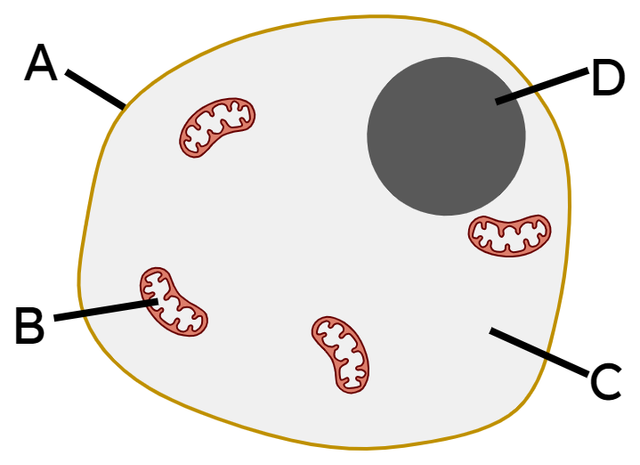Starter quiz
- What are all living organisms made of?
- tissue
- cells ✓
- organs
- system
-
 What type of cell is shown in the image?
What type of cell is shown in the image?- plant cell ✓
- animal cell
- bacterial cell
-
 What type of cell is shown in the image?
What type of cell is shown in the image?- plant cell
- animal cell
- bacterial cell ✓
-
 Shown in the image is an animal cell. What is label A pointing to?
Shown in the image is an animal cell. What is label A pointing to?- cell wall
- cell membrane ✓
- nucleus
- cytoplasm
-
- What is the function of the nucleus of a cell?
- it is the brain of the cell
- it controls what enters and leaves the cell
- it contains genetic material that controls the cell ✓
- it contains enzymes that control respiration
-
- Which of the following are found in plant cells but not animal cells?
- nucleus
- cytoplasm
- permanent vacuole ✓
- chloroplasts ✓
-
Exit quiz
- What does the term 'multicellular organism' mean?
- an organism that can be seen without a microscope
- an organism that consists of one cell
- an organism made up of many cells ✓
- an organism that can only be seen with a microscope
-
- Which of the following is true for unicellular organisms?
- they consist of one cell ✓
- they can usually be seen with the unaided eye
- they are all bacteria
- they are usually microscopic ✓
-
- Starting with the smallest, sort the organisational structure of multicellular organisms into the correct order.
- 1⇔cell
- 2⇔tissue
- 3⇔organ
- 4⇔organ system
- 5⇔organism
- Which of the following are found in both plant and animal cells?
- nucleus ✓
- cytoplasm ✓
- chloroplasts
- cell wall
- cell membrane ✓
-
- Match the following structures with their functions.
- cytoplasm⇔jelly-like substance where chemical reactions take place ✓
- nucleus⇔contains DNA, which controls the cell activities ✓
- mitochondria⇔where energy is released through aerobic respiration ✓
- cell wall⇔contains cellulose, which provides strength and support to cell ✓
- Match the following structures with their functions.
- ribosomes⇔where protein synthesis occurs ✓
- cell membrane⇔controls what enters and exits the cell ✓
- permanent vacuole⇔contains sap which helps keep the cell turgid ✓
- chloroplast⇔contains chlorophyll, which is where photosynthesis occurs ✓
Worksheet
Loading worksheet ...
Presentation
Loading presentation ...
Video
Lesson Details
Key learning points
- All organisms (including animals, plants, fungi and micro-organisms) are made up of one or more living cells.
- All cells have some structures in common (cell membrane and cytoplasm) and have a three-dimensional shape.
- Chemical reactions essential to life occur in cytoplasm; the cell membrane regulates the cell’s internal environment.
- Many animals and plants are multicellular; they are made up of many cells organised to form tissues and organs.
- Micro-organisms such as bacteria are unicellular – they are made of just one cell.
Common misconception
Pupils may think that all animals and plant are multicellular and that all unicellular organisms are bacteria.
Lesson explicitly addresses this misconception and the questions in Task A are designed to expose the misconception.
Keywords
Organism - A living thing made of one or more cells.
Cell - The basic unit of all forms of life.
Multicellular - An organism made of many cells.
Micro-organism - An organism that can only be viewed through a microscope.
Unicellular - An organism that consists of a single cell.
+